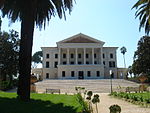Santa Costanza is a 4th-century church in Rome, Italy, on the Via Nomentana, which runs north-east out of the city. It is a round building with well preserved original layout and mosaics. It has been built adjacent to a horseshoe-shaped church, now in ruins, which has been identified as the initial 4th-century cemeterial basilica of Saint Agnes. (Note that the much later Church of St Agnes, still standing nearby, is distinct from the older ruined one.) Santa Costanza and the old Saint Agnes were both constructed over the earlier catacombs in which Saint Agnes is believed to be buried.
According to the traditional view, Santa Costanza was built around the reign of Constantine I as a mausoleum for his daughter Constantina, later also known as Constantia or Costanza, who died in AD 354. However, more recent excavations have called this date (and therefore the original purpose of the building) into question. Ultimately, Constantina's sarcophagus was housed here, but it may have been moved from an earlier location.The mausoleum is of circular form with an ambulatory surrounding a central dome. The fabric of Santa Costanza survives in essentially its original form. Despite the loss of the coloured stone veneers of the walls, some damage to the mosaics and incorrect restoration, the building stands in excellent condition as a prime example of Early Christian art and architecture. The vaults of the apses and ambulatory display well preserved examples of Late Roman mosaics. A key component which is missing from the decorative scheme is the mosaic of the central dome. In the sixteenth century, watercolours were made of this central dome so the pictorial scheme can be hypothetically reconstructed. The large porphyry sarcophagus of either Constantina or her sister Helena has survived intact, and is now in the Vatican Museum – an object of great significance to the study of the art of Late Antiquity.










